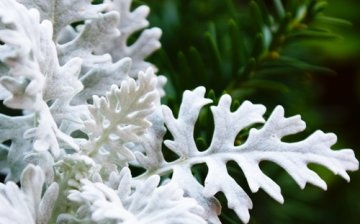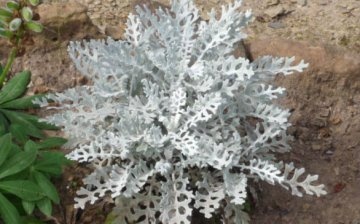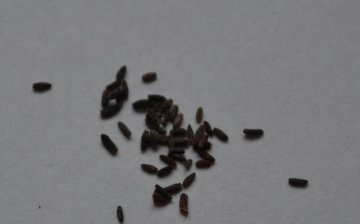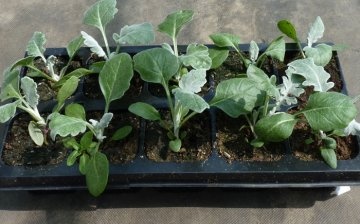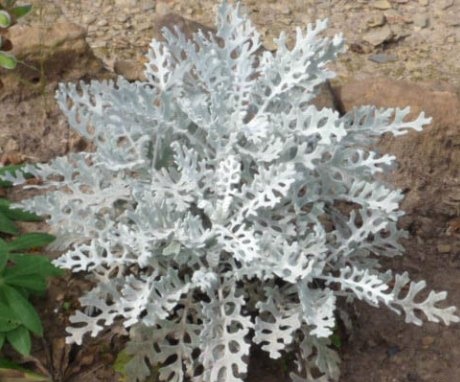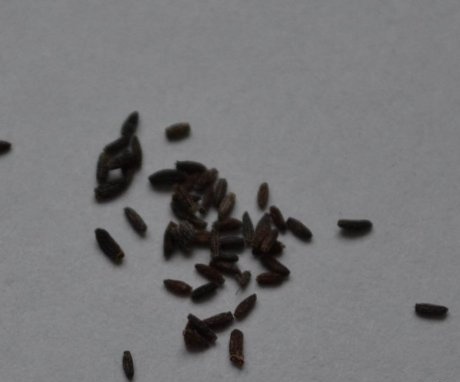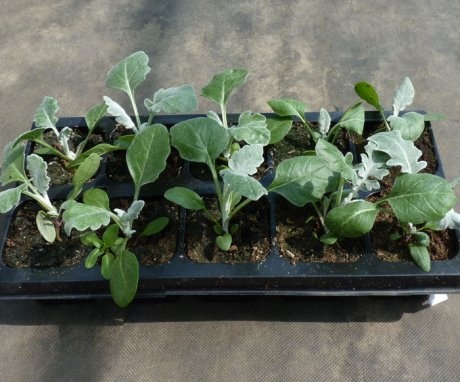Cineraria seaside: appearance and cultivation on the site
Seaside cineraria (Latin name Сineraria maritima) is an ornamental shrub plant belonging to the Aster family. In central Russia, it is grown as an annual shrub, as it does not tolerate low temperatures very well. In the southern regions, it is quite capable of surviving the winter, therefore it is used as a perennial ornamental plant. The homeland of cineraria is the Mediterranean, it is there that it still grows in natural conditions.
Content:
- Appearance and growing conditions
- Planting cineraria seaside
- Cineraria care: what you need to know?
- Decorative use of cineraria
Appearance and growing conditions
This type of cineraria became widespread in summer cottages and household plots, as it has an unusual appearance and is used to decorate flower beds and lawn fencing. It is also used for the original design of rockeries and alpine slides: neat silvery bushes look great as a fence along garden paths.
The Latin name "Cineraria" is translated as "ashy", which is explained by the interesting silvery color of the leaves.
They have an unusual pinnacle shape, openwork pubescent leaves form a small bush in height - the largest specimens do not exceed half a meter.
There are two main varieties of cineraria that are widespread:
- The first variety, Cirrus, is a shrub that reaches a height of 45 cm. The leaves are initially silvery-green in color, which then becomes silvery-white.
- The second common variety is Silver Dust. It is found even more often, the main difference is a dense rosette of cut silvery leaves, the height of the shrub rarely exceeds 25 cm.
In the first year after planting, a leaf rosette is formed, each leaf has a velvety surface to the touch. From the second year after planting, cineraria begins to bloom, forming small inflorescences-shields. The flowers themselves are yellow, and their decorative qualities are small. If the propagation of cineraria by seeds is not expected, gardeners prefer to remove the inflorescences.
Cineraria seaside prefers places where there is a lot of sun, since it is the sunlight that provides the rich white color of the leaf outlet.
It is not very demanding for watering, it is important that there is enough moisture at the beginning of the season. On the contrary, waterlogging of the soil can lead to rotting of the roots, so it is important not to allow too much watering.
Planting cineraria seaside
Planting cineraria as an annual plant involves the use of cuttings. Seed propagation you need to start back in April: the seeds are sown in pots to a depth of about 1 cm, the soil should be moistened. it must be covered with plastic wrap or glass. The temperature in the room with the seedlings should be about 18 degrees. Already at the end of the first week, the first shoots may appear.
When choosing a place for a plant and the planting itself, several requirements must be taken into account:
- Cineraria is not demanding on the choice of soil, but loose soil, richly supplied with organic fertilizers, is most suitable for it.
- The soil at the planting site should have a good drainage layer so that water does not stagnate and destroy the root system.
- It is advisable to choose slightly shaded areas, however, in an open space, cineraria will grow without problems.
- When the first true leaves appear in the grown seedlings, they dive. Plants can be transplanted into open ground starting from about mid-May.
- You need to plant plants at a distance of 25-30 cm from each other. This is necessary so that, during growth, the bushes do not interfere with each other, and the leaf rosette takes the correct shape.
- When transplanting, young seedlings are taken out together with a lump of earth so as not to damage the root system. This land does not need to be shaken off; the plant is placed in the soil with it.
- After planting, the plant begins to develop rapidly. The bushes usually take root well, and after a month they will give lush shoots. A leaf rosette forms very soon; outwardly, they will slightly resemble a wild-growing wormwood.
Planting seaside cineraria in open ground is not a very difficult matter.
Already in the second year of working with this amazing plant, it will be very easy for you to decorate your site with silvery-white bushes, which will be an excellent decoration for any flower bed.
Cineraria care: what you need to know?
Although this the plant is quite undemanding to care, you need to know some of the requirements for watering and fertilizing.
The main condition: cineraria does not tolerate low temperatures, any frost can completely destroy the plant.
If it is supposed to plant cineraria as an annual plant, then for the winter it must be covered with dry leaves or straw, but even then it may not survive the cold period. One more way out - for a while transplant a plant in a large pot, and in the spring, move it back to the open ground.
The basic rules for caring for cineraria are easy to follow.
Even an inexperienced gardener can handle this:
- At first, you need to ensure regular abundant watering, since the plant will actively build up its vegetative mass. In the future, the amount of moisture can be reduced: cineraria calmly tolerates even severe drought, since it has a very powerful root system.
- When watering, you need to make sure that water does not fall on the leaves. You need to water so that the water enters the aisles and is evenly distributed between individual bushes.
- Fertilizer with a low nitrogen content is applied to the soil 1-2 times a month. Complex fertilizer can also be applied to the soil once a month. In general, cineraria can grow on poor soils, but timely feeding will ensure good leaf growth.
- After wintering, you need to carefully examine the bushes: they remove frozen and dried leaves from them so that they do not interfere with the rapid growth of new shoots.
- Cineraria easily restores deciduous mass, this plant is rarely affected by pests. The main problems are aphids and powdery mildew, if you notice the appearance of pests, the plant needs to be treated with special compounds.
Proper care of cineraria and comfortable wintering conditions will make this plant perennial. In the spring it will completely restore its appearance, and from the second year, small yellow flowers will appear on it.
Decorative use of cineraria
The main purpose of the seaside cineraria in landscape design is to create a background and framing for other plants.
Due to its unusual color, this shrub is often used with blue and hot pink flowers to create compositions. It goes well with pink begonia, coleus, lubelia and other common ornamental plants.
In addition, with the help of cineraria, it is easy to highlight any area on the site: it will become the best frame for a flower garden, with its help you can arrange a recreation area or plant it along a beautiful alley.Since this is an undemanding plant, cineraria curbs can be created throughout the site, it calmly tolerates both sunny and shaded areas.
Cineraria is often used when creating large landscape compositions: it is used as a background if flowers are planted in the form of inscriptions or any symbols.
Having planted cineraria on the site seaside, you can provide a beautiful and neat look of the flower beds, this plant does not cause any particular trouble and pleases with a neat interesting look. This is an excellent solution for modern landscaping, and the plant does not require special care.
More information about the seaside conservatory can be found in the video.



